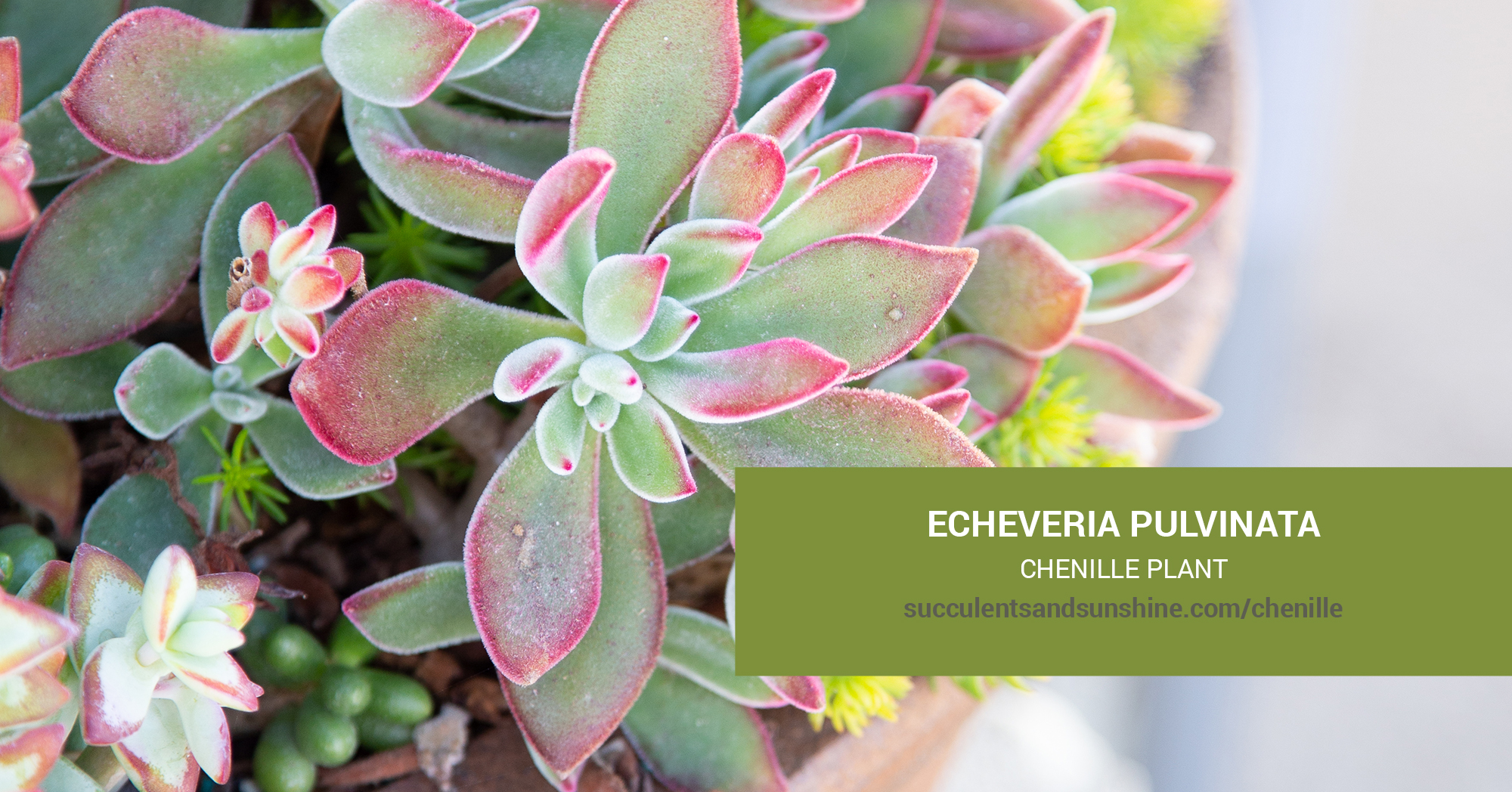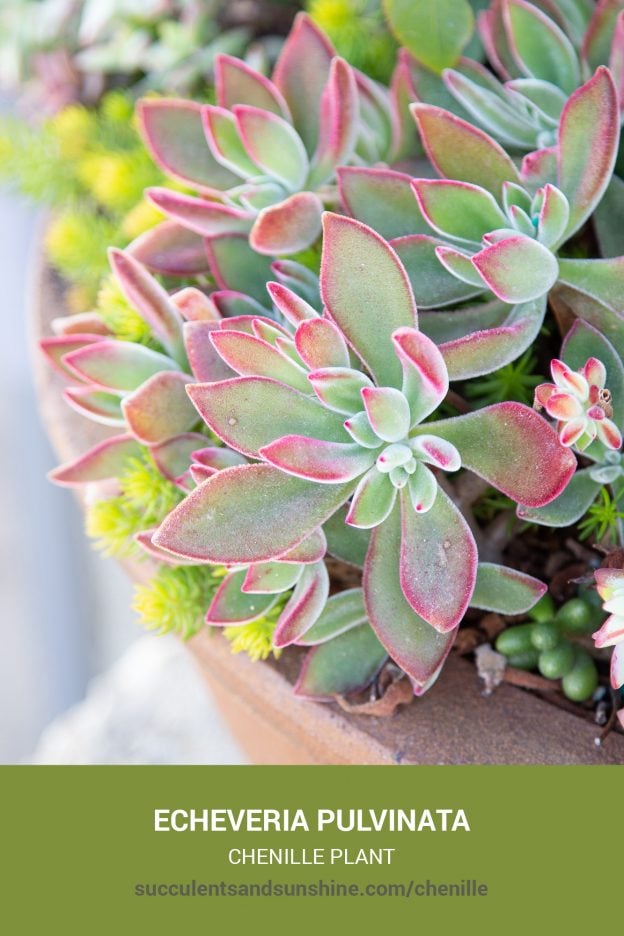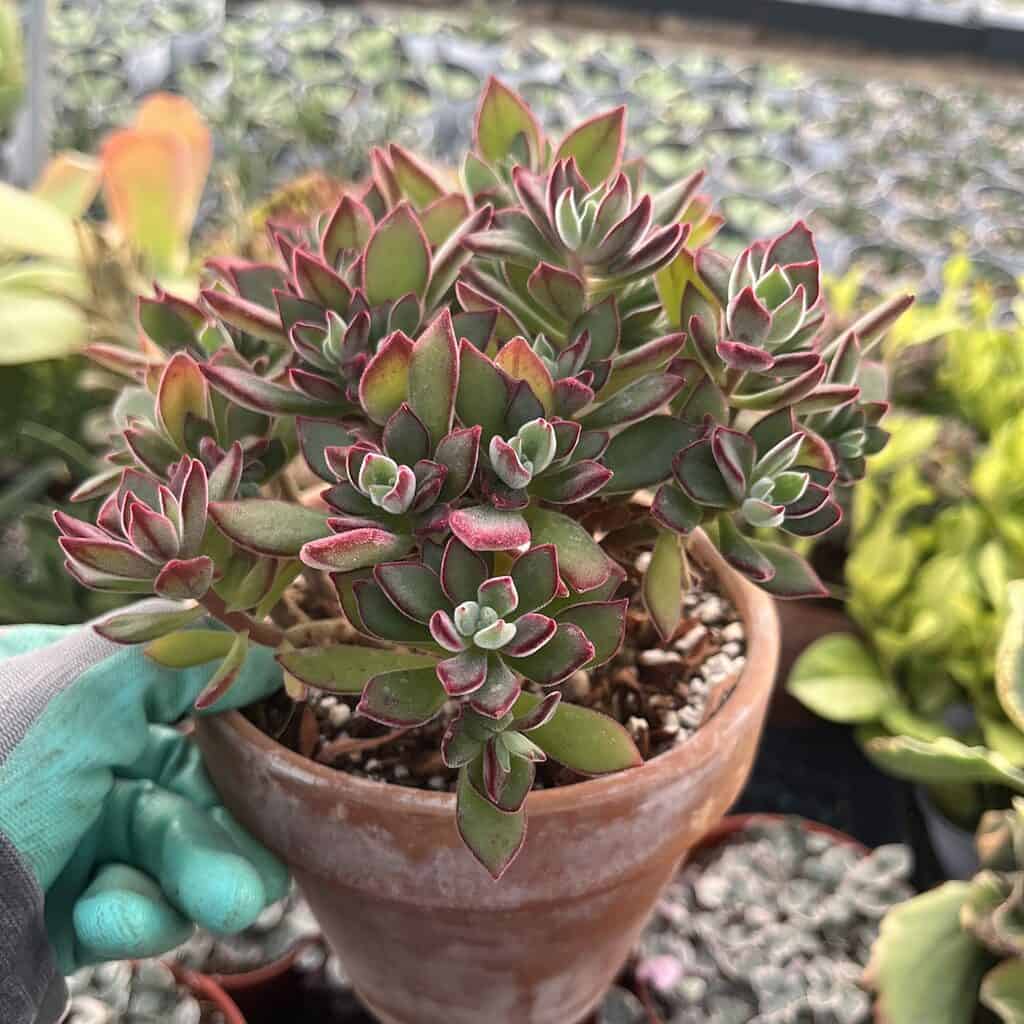This soft, fuzzy succulent has vivid green leaves with pink to red edges. Each leaf has small white hairs that help guard against water evaporation. Look out for orange blossoms in the Springtime.
Table of Contents
Care and Propagation Information
Echeveria pulvinata “Chenille Plant” is an attractive addition to any succulent display, as its foliage can add a splash of color and height to the arrangement. Depending on the variety, it may reach a considerable size. Also, its blooms have the ability to draw hummingbirds to the garden.
Watering
Echeveria pulvinata “Chenille Plant” should be watered using the “soak and dry” method, allowing the soil to dry out completely before watering again.
Where to Plant
If you live in a climate where the temperature drops below 20° F (-6.7° C), it is advisable to grow Chenille Plant in a container that can be brought indoors. This succulent prefers a spot that receives full or partial sunlight.
Put your plants in a spot where they will get at least 6 hours of direct sunlight each day. If you are growing indoors, pick a room that is well lit, preferably near a south-facing window (in the Northern Hemisphere).
How to Propagate Echeveria pulvinata “Chenille Plant”
The Echeveria pulvinata “Chenille Plant” can be propagated through taking stem cuttings or using leaves.
Cuttings
To propagate a “Chenille Plant”, use a sharp, clean knife or a pair of scissors. Cut a stem from the main plant and let it heal for a few days before planting it in soil that drains well. Make sure to keep the soil moist by watering when it becomes completely dry.
Leaves
To propagate a “Chenille Plant”, take a leaf from the mother plant and twist it off so that none of the leaf remains attached to the stem. Doing this will give you the best chance of success.
Allow the leaf to sit in a dry area for a few days so that the end hardens, and then transfer it to a pot with soil that drains well. Water the soil only once it has completely dried out.
Care and Propagation Information
General Care for Echeveria pulvinata “Chenille Plant”
Watering
Echeveria pulvinata “Chenille Plant” should be watered using the “soak and dry” method, allowing the soil to dry out completely before watering again.
Where to Plant
If you live in a climate where the temperature drops below 20° F (-6.7° C), it is advisable to grow Chenille Plant in a container that can be brought indoors. This succulent prefers a spot that receives full or partial sunlight.
Put your plants in a spot where they will get at least 6 hours of direct sunlight each day. If you are growing indoors, pick a room that is well lit, preferably near a south-facing window (in the Northern Hemisphere).
How to Propagate Echeveria pulvinata “Chenille Plant”
The Echeveria pulvinata “Chenille Plant” can be propagated through taking stem cuttings or using leaves.
Cuttings
To propagate a “Chenille Plant”, use a sharp, clean knife or a pair of scissors. Cut a stem from the main plant and let it heal for a few days before planting it in soil that drains well. Make sure to keep the soil moist by watering when it becomes completely dry.
Leaves
To propagate a “Chenille Plant”, take a leaf from the mother plant and twist it off so that none of the leaf remains attached to the stem. Doing this will give you the best chance of success.
Allow the leaf to sit in a dry area for a few days so that the end hardens, and then transfer it to a pot with soil that drains well. Water the soil only once it has completely dried out.
FAQ
How often do you water Echeveria pulvinata?
How do you care for Echeveria pulvinata?
When caring for drought tolerant cactus and succulents, be sure to water them infrequently but deeply. Let the soil completely dry out before you water again. Avoid getting the rosettes wet, as this could lead to fungal diseases and rotting. Feed your plants sparingly with a standard cactus fertilizer during the growing season.
Does Echeveria need sun or shade?
Paraphrase: Sunlight: Many gardeners who are growing succulents do not provide adequate light for their plants. Make sure to place your echeveria in a spot near a window where it can receive a minimum of six hours of direct sunlight daily. If the plant does not get enough light, it will start to sprawl and lose its compact shape.
How do you care for a dwarf chenille plant indoors?
To ensure the health and growth of a Dwarf Chenille Plant, make sure to adequately water and fertilize it during the growing season. Additionally, this houseplant does best in high humidity, so it is recommended to put the pot on a tray of wet pebbles or use a cool-mist room humidifier close by to help raise the humidity level.
How do you care for a chenille plant succulent?
Chenille plant does best when it is exposed to full to partial sunlight, but it is important to avoid direct afternoon sun. As an indoor plant, it is ideal to grow it in a greenhouse or in a south-facing window, which will provide it with consistent year-round light.



